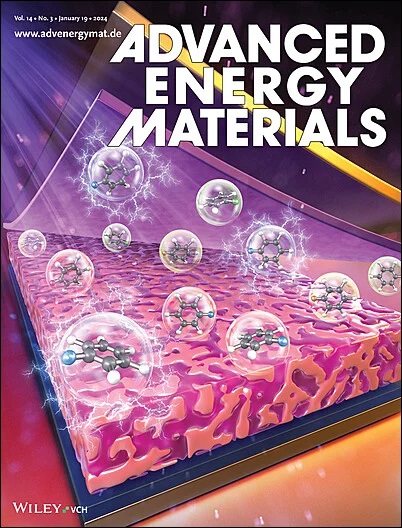Indenocarbazole‐Engineered Self‐Assembled Monolayers with Sterically Tuned π‐Stacking for High‐Efficiency p–i–n Perovskite Solar Cells
IF 24.4
1区 材料科学
Q1 CHEMISTRY, PHYSICAL
引用次数: 0
Abstract
Terminal π‐extension is crucial for fabricating highly ordered self‐assembled monolayers (SAMs) that facilitate efficient hole transport in perovskite solar cells (PSCs). However, π‐expanded conjugation may compromise SAM film quality and ultimately degrading interfacial properties in p–i–n PSCs. To resolve this trade‐off, SAMs incorporating an indenocarbazole (InCz) terminal group are designed, which simultaneously addresses both molecular ordering and film formation challenges. The InCz‐terminated PAInCz demonstrates optimal balance through: 1) strengthened高效p-i-n钙钛矿太阳能电池中具有立体调谐π堆叠的茚甲唑工程自组装单层膜
在钙钛矿太阳能电池(PSCs)中,终端π延伸对于制造高度有序的自组装单层(sam)至关重要,sam有助于高效的空穴传输。然而,π扩展共轭可能会损害SAM膜质量,最终降低p-i-n psc的界面性能。为了解决这一问题,设计了包含吲哚咔唑(InCz)末端基团的sam,同时解决了分子有序和薄膜形成的挑战。末端为InCz的PAInCz通过以下途径展示了最佳平衡:1)加强π相互作用,实现密集有序的分子堆叠;2)二甲基位阻提高薄膜质量。值得注意的是,虽然PAInCz表现出优异的性能,包括增强的钙钛矿界面接触,强大的ITO衬底锚定和有利的能量排列,但其π‐扩展的对应物Ph‐PAInCz(具有扩展的终端和连接基团)显示出器件性能下降。这种对比突出了可控π共轭在SAM设计中的重要性。优化后的基于PAInCz的倒置PSCs实现了25.51%的冠军功率转换效率,并具有出色的运行稳定性,保持了>;连续光浸泡500 h (AM1.5G)和热应力测试(65℃)后初始PCE的85%。这些发现为sam的π延伸端和连接体如何影响钙钛矿太阳能电池的性能提供了基本的见解。
本文章由计算机程序翻译,如有差异,请以英文原文为准。
求助全文
约1分钟内获得全文
求助全文
来源期刊

Advanced Energy Materials
CHEMISTRY, PHYSICAL-ENERGY & FUELS
CiteScore
41.90
自引率
4.00%
发文量
889
审稿时长
1.4 months
期刊介绍:
Established in 2011, Advanced Energy Materials is an international, interdisciplinary, English-language journal that focuses on materials used in energy harvesting, conversion, and storage. It is regarded as a top-quality journal alongside Advanced Materials, Advanced Functional Materials, and Small.
With a 2022 Impact Factor of 27.8, Advanced Energy Materials is considered a prime source for the best energy-related research. The journal covers a wide range of topics in energy-related research, including organic and inorganic photovoltaics, batteries and supercapacitors, fuel cells, hydrogen generation and storage, thermoelectrics, water splitting and photocatalysis, solar fuels and thermosolar power, magnetocalorics, and piezoelectronics.
The readership of Advanced Energy Materials includes materials scientists, chemists, physicists, and engineers in both academia and industry. The journal is indexed in various databases and collections, such as Advanced Technologies & Aerospace Database, FIZ Karlsruhe, INSPEC (IET), Science Citation Index Expanded, Technology Collection, and Web of Science, among others.
 求助内容:
求助内容: 应助结果提醒方式:
应助结果提醒方式:


